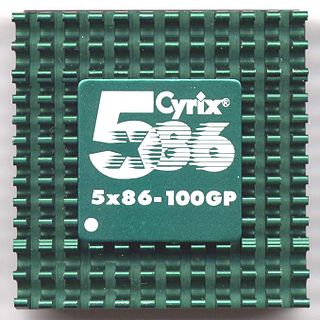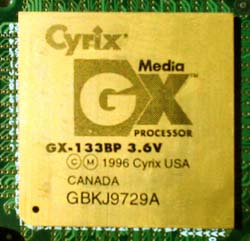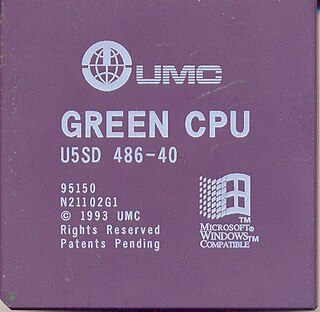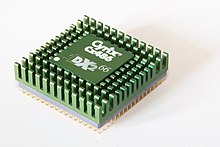
Athlon is the brand name applied to a series of x86-compatible microprocessors designed and manufactured by AMD. The original Athlon was the first seventh-generation x86 processor and the first desktop processor to reach speeds of one gigahertz (GHz). It made its debut as AMD's high-end processor brand on June 23, 1999. Over the years AMD has used the Athlon name with the 64-bit Athlon 64 architecture, the Athlon II, and Accelerated Processing Unit (APU) chips targeting the Socket AM1 desktop SoC architecture, and Socket AM4 Zen (microarchitecture). The modern Zen-based Athlon with a Radeon Graphics processor was introduced in 2019 as AMD's highest-performance entry-level processor.

The Intel 486, officially named i486 and also known as 80486, is a microprocessor. It is a higher-performance follow-up to the Intel 386. The i486 was introduced in 1989. It represents the fourth generation of binary compatible CPUs following the 8086 of 1978, the Intel 80286 of 1982, and 1985's i386.

The Inteli486DX2, rumored as 80486DX2, is a CPU produced by Intel that was first introduced in 1992. The i486DX2 was nearly identical to the i486DX, but it had additional clock multiplier circuitry. It was the first chip to use clock doubling, whereby the processor runs two internal logic clock cycles per external bus cycle. An i486 DX2 was thus significantly faster than an i486 DX at the same bus speed thanks to the 8K on-chip cache shadowing the slower clocked external bus.

Duron is a line of budget x86-compatible microprocessors manufactured by AMD and released on June 19, 2000. Duron was intended to be a lower-cost offering to complement AMD's then mainstream performance Athlon processor line, and it also competed with rival chipmaker Intel's Pentium III and Celeron processor offerings. The Duron brand name was retired in 2004, succeeded by the AMD's Sempron line of processors as their budget offering.

Celeron is a discontinued series of low-end IA-32 and x86-64 computer microprocessor models targeted at low-cost personal computers, manufactured by Intel. The first Celeron-branded CPU was introduced on April 15, 1998, and was based on the Pentium II.

Cyrix Corporation was a microprocessor developer that was founded in 1988 in Richardson, Texas, as a specialist supplier of floating point units for 286 and 386 microprocessors. The company was founded by Tom Brightman and Jerry Rogers.

The Pentium II brand refers to Intel's sixth-generation microarchitecture ("P6") and x86-compatible microprocessors introduced on May 7, 1997. Containing 7.5 million transistors, the Pentium II featured an improved version of the first P6-generation core of the Pentium Pro, which contained 5.5 million transistors. However, its L2 cache subsystem was a downgrade when compared to the Pentium Pros. It is a single-core microprocessor.

The Cyrix 5x86 is a line of x86 microprocessors designed by Cyrix and released on June 5 of 1995. Cyrix, being a fabless company, had the chips manufactured by IBM. The line came out about 5 months before the more famous Cyrix 6x86. The Cyrix 5x86 was one of the fastest CPUs ever produced for Socket 3 computer systems. With better performance in most applications than an Intel Pentium processor at 75 MHz, the Cyrix Cx5x86 filled a gap by providing a medium-performance processor option for 486 Socket 3 motherboards.

The Am5x86 processor is an x86-compatible CPU announced in November of 1995 by AMD for use in 486-class computer systems. It began shipping in December of 1995, with a base price of $93 per unit in bulk quantities. Before being released, it was in development under the codename "X5".
The Pentium OverDrive was a microprocessor marketing brand name used by Intel, to cover a variety of consumer upgrade products sold in the mid-1990s. It was originally released for 486 motherboards, and later some Pentium sockets. Intel dropped the brand, as it failed to appeal to corporate buyers, and discouraged new system sales.

The K6-2 is an x86 microprocessor introduced by AMD on May 28, 1998, and available in speeds ranging from 266 to 550 MHz. An enhancement of the original K6, the K6-2 introduced AMD's 3DNow! SIMD instruction set and an upgraded system-bus interface called Super Socket 7, which was backward compatible with older Socket 7 motherboards. It was manufactured using a 250 nanometer process, ran at 2.2 volts, and had 9.3 million transistors.

The K6-III was an x86 microprocessor line manufactured by AMD that launched on February 22, 1999. The launch consisted of both 400 and 450 MHz models and was based on the preceding K6-2 architecture. Its improved 256 KB on-chip L2 cache gave it significant improvements in system performance over its predecessor the K6-2. The K6-III was the last processor officially released for desktop Socket 7 systems, however later mobile K6-III+ and K6-2+ processors could be run unofficially in certain socket 7 motherboards if an updated BIOS was made available for a given board. The Pentium III processor from Intel launched 6 days later.

The Am386 CPU is a 100%-compatible clone of the Intel 80386 design released by AMD in March 1991. It sold millions of units, positioning AMD as a legitimate competitor to Intel, rather than being merely a second source for x86 CPUs.

The Cyrix Cx486SLC is a x86 microprocessor that was developed by Cyrix. It was one of Cyrix's first CPU offerings, released after years of selling math coprocessors that competed with Intel's units and offered better performance at a comparable or lower price. It was announced in March of 1992, and released 2 months later in May, with a price of $119. It was priced competitively against the Intel 486SX, causing Intel to lower the price of their chip from $286 to $119 in just days.

The Cyrix Cx486DLC is an x86 desktop microprocessor developed by Cyrix. It was Cyrix's second CPU offering, released years after selling math coprocessors that competed with Intel's units and offered better performance at a comparable or lower price. It was released in June of 1992, with a price of $119 for computer manufacturers.

Geode was a series of x86-compatible system-on-a-chip (SoC) microprocessors and I/O companions produced by AMD, targeted at the embedded computing market.

The MediaGX CPU is an x86-compatible processor that was designed by Cyrix and manufactured by National Semiconductor following the two companies' merger. It was introduced in 1997. The core is based on the integration of the Cyrix Cx5x86 CPU core with hardware to process video and audio output. Following the buyout of Cyrix by National Semiconductor and the sale of the Cyrix name and trademarks to VIA Technologies, the core was developed by National Semiconductor into the Geode line of processors, which was subsequently sold to Advanced Micro Devices.
The 386SLC is an Intel-licensed version of the 386SX, developed and manufactured by IBM in 1991. It included power-management capabilities and an 8KB internal CPU cache, which enabled it to yield comparable performance to 386DX processors of the same clock speed, which were considerably more expensive. Known inside IBM as "Super Little Chip" for its initials, it was used in the IBM PS/2 35, 40 and 56 Series and in the IBM PS/ValuePoint 325T, but never gained much market share. This was mainly due to an agreement with Intel, in which IBM was not allowed to sell their CPUs if they were not part of a system or upgrade board. It was also marketed as an optional upgrade for 8086-equipped IBM PS/2 25 Series computers.

Cyrix III is an x86-compatible Socket 370 CPU. VIA Technologies launched the processor in February 2000. VIA had purchased both Centaur Technology and Cyrix. Cyrix III was to be based upon a core from one of the two companies.

The UMC Green CPU was an x86-compatible microprocessor produced by UMC, a Taiwanese semiconductor company, in the early- to mid-1990s. It was offered as an alternative to the Intel 80486 with which it was pin compatible, enabling it to be installed in most 80486 motherboards. All models had power management features intended to reduce electricity consumption.

























